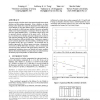100
click to vote
VLDB
2007
ACM
15 years 20 days ago
2007
ACM
Workload management for business intelligence (BI) queries poses different challenges than those addressed in the online transaction processing (OLTP) context. The fundamental pro...
112
click to vote
VLDB
2007
ACM
15 years 20 days ago
2007
ACM
Views over probabilistic data contain correlations between tuples, and the current approach is to capture these correlations using explicit lineage. In this paper we propose an al...
VLDB
2007
ACM
15 years 20 days ago
2007
ACM
Existing work on similar sequence matching has focused on either whole matching or range subsequence matching. In this paper, we present novel methods for ranked subsequence match...
VLDB
2007
ACM
15 years 20 days ago
2007
ACM
We present XBenchMatch, a benchmark which uses as input the result of a schema matching algorithm (set of mappings and/or an integrated schema) and generates statistics about the ...
VLDB
2007
ACM
15 years 20 days ago
2007
ACM
Correctly generating a structured query (e.g., an XQuery or a SQL query) requires the user to have a full understanding of the database schema, which can be a daunting task. Alter...
101
click to vote
VLDB
2007
ACM
15 years 20 days ago
2007
ACM
As computer systems are essential components of many critical commercial services, the need for secure online transactions is now becoming evident. The demand for such application...
VLDB
2007
ACM
15 years 20 days ago
2007
ACM
Recent research on skyline queries has attracted much interest in the database and data mining community. Given a database, an object belongs to the skyline if it cannot be domina...
VLDB
2007
ACM
15 years 20 days ago
2007
ACM
In this paper we discuss advances in self-tuning database systems over the past decade, based on our experience in the AutoAdmin project at Microsoft Research. This paper primaril...
VLDB
2007
ACM
15 years 20 days ago
2007
ACM
This demonstration showcases the STEP system for natural language access to relational databases. In STEP an administrator authors a highly structured semantic grammar through cou...
VLDB
2007
ACM
15 years 20 days ago
2007
ACM
We present STAR, a self-tuning algorithm that adaptively sets numeric precision constraints to accurately and efficiently answer continuous aggregate queries over distributed data...






